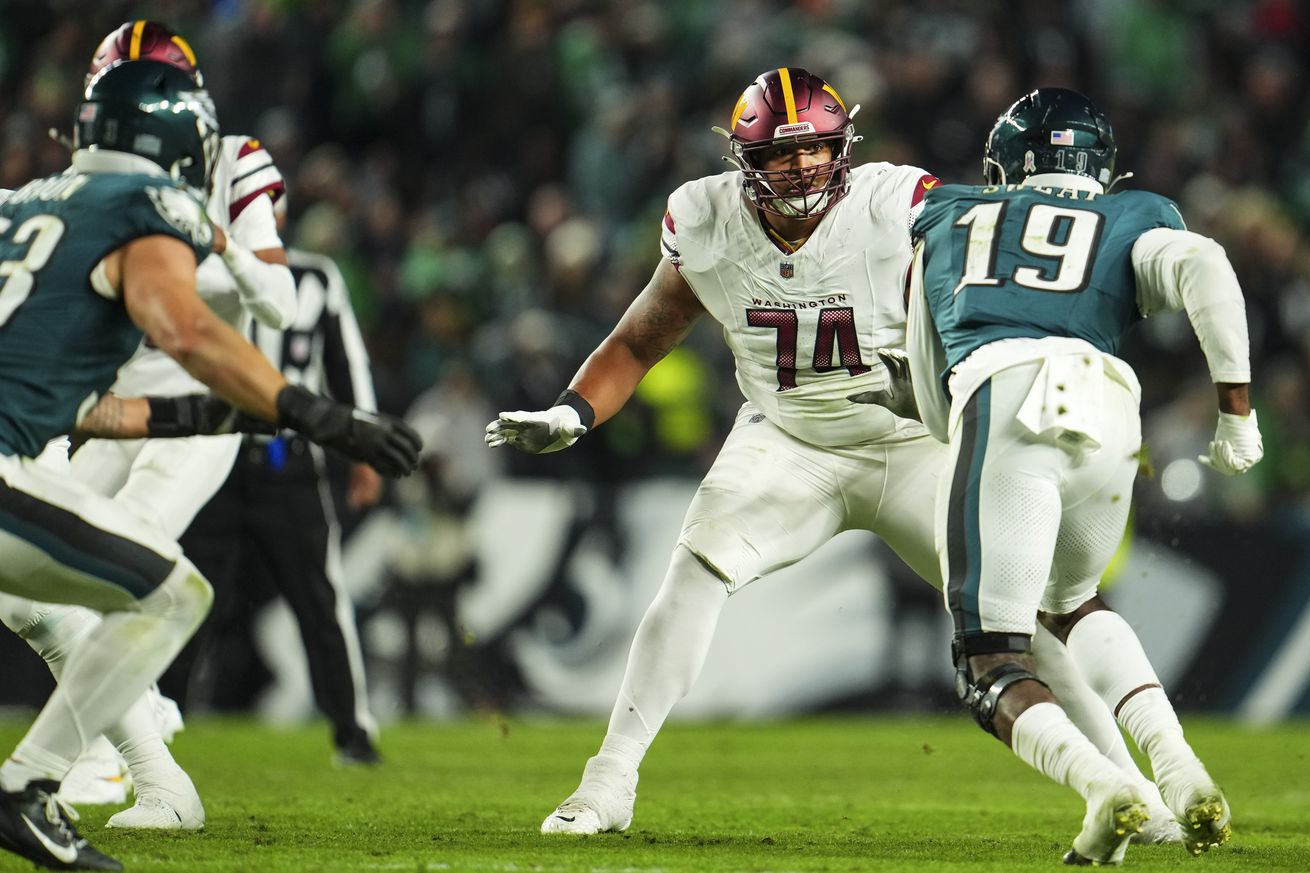
Clues from development timelines of starting LTs in pass protection since 2017
Among the many questions facing the Commanders in the coming offseason is whether 2024 third round pick, Brandon Coleman can provide a long-term solution at left tackle.
Entering the draft, most analysts projected Coleman to move to guard in the NFL (e.g. NFL.com’s Lance Zierlein). Coleman had a breakout sophomore season for the TCU Horned Frogs at left guard and moved to left tackle as a junior. He was moved back to left guard to start his final season, then switched back to LT for the final seven games.
At 6’ 4.5” and 312 lbs, with 34 5/8” arms, Coleman has good size and length for the position. In fact, his combine measurements are very similar to 3x All-Pro Trent Williams. The main concerns in scouting reports were questions about reactive athleticism to keep up with speed rushers and lack of leg strength to generate movement as a run blocker.
The Commanders clearly saw something different when they scouted Coleman. In his comments following the Day 2 of the draft, GM Adam Peters had this to say about his third round selection:
Brandon I think will come in and compete just like everybody else. And we certainly think he has what it takes to be a tackle in this league. And he’s got the feet, he’s got the speed, he’s got the strength, and he’s got the intelligence and he’s got the right mindset and so he’ll come in and compete just like everybody else.
In his rookie season, Coleman has lined up exclusively at LT. Throughout the first seven games, he alternated offensive series with veteran starter Cornelius Lucas, ramping up from 14 snaps in the season opener to around 50% of offensive snaps by Week 3. He was injured in the Week 7 game against Carolina. When he returned to the lineup for the Week 9 match against the Giants, he took over as the full-time starter, where he has remained in every game since.
Coleman’s performance in pass protection and run blocking has been up and down throughout his rookie campaign. That is typical of rookie offensive tackles, particularly those drafted after the first half of Round 1. A question that gets asked every week in discussion threads on Hogs Haven is whether we are just seeing rookie jitters, or whether Coleman’s lapses mean that he his is not cut out to play left tackle long-term?
It should be well known that offensive linemen usually face a steep learning curve to adjust to the speed of the NFL. The question I will attempt to address in this set of two articles is how long does that usually take? For those fans who remain hopeful that Coleman is the real deal, how long can we keep making excuses that the occasional sacks and pressures allowed are just bumps in the road? And more importantly, at what point should Adam Peters decide if he needs to invest more resources in upgrading Jayden Daniels’ blindside protection?
While these articles are about Brandon Coleman, I won’t actually get to his blocking stats until the second in the mini-series. To set the scene, the first article takes a look at the recent timeline of development of starting left tackles in pass protection. Data from recently drafted starting left tackles will help to calibrate our expectations for Coleman’s development. With that out of the way, the second article will examine Coleman’s blocking stats to see how he is progressing against milestones set by OTs who have earned starting roles during their rookie contracts.
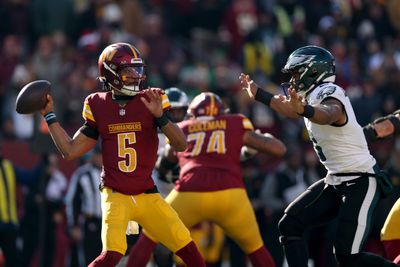
Photo by Scott Taetsch/Getty Images
Blocking Stats
This season I have made considerable effort to identify blocking stats that accurately reflect performance in pass protection and run blocking. Those efforts have been successful with respect to pass protection, and entirely fruitless with respect to run blocking. Therefore, these articles will only examine development of offensive tackles in pass blocking. Looking back to the discussions on Hogs Haven last offseason, an overriding concern among many was whether the Commanders had done enough to shore up pass protection for their rookie QB. So, I am hopeful this will give fans enough to think about, even without delving into run blocking.
Pass Protection
Since my roundup of the Commanders’ pass protection in 2023 last offseason, I have settled on Pressure Rate as the most informative metric for pass blocking. Pressure Rate is simply the percentage of pass blocking snaps on which a player allowed pressure (QB Hurry, QB Hit, Sack; data sourced from Pro Football Focus). Pressure Rate is more informative about blocking performance than sacks allowed, because the latter is a combined effort of blocker and QB. In my preseason article on the Commanders’ left guard position, I showed that Pressure Rate, derived from PFF stats, was strongly correlated with Sports Info Solutions’ Blown Block Rate for pass blocking, providing independent validation.
What the numbers mean? Examining blocking stats from large numbers of OTs has revealed that Pressure Rate in pass protection, on its own, is highly predictive of career outcomes. OTs who consistently allow pressure on less than 5% of snaps tend to get locked up long-term on premium starting contracts. OTs who plateau at Pressure Rates between 5% and 6% will often find work as starters, but their careers are less secure, and they tend to bounce between teams. OTs who don’t get below 6% Pressure Rate reliably, tend to end up as backups, switch to other positions, or both. The median Pressure Rate values for starting OTs in any given season generally fall in the mid-5% range.
In addition to being predictive of career success, Pressure Rate in pass protection has proven to be a sensitive indicator of an OT’s situation. When I first started working with the data, it appeared that individual players’ numbers have a lot of jitter from season to season. Further investigation revealed that sudden spikes from one season to the next nearly always coincided with major injuries, changing QBs or changing teams.
Why Not Run Blocking?
Quite simply, I haven’t been able to find a metric for run blocking with analytical validity that passes the eye test. Pro Football Focus player grades are widely cited. While they are generated from film breakdowns, through a quality assured process, it’s not clear to me what subjective grades of a players’ overall contribution to success of play actually tells us. Sports Info Solutions blown block rates were suggested as an alternative. I got as far as discovering that 2023 All-Pro Penei Sewell ranked 23rd in run blocking among starting RTs by that metric, before concluding that it had failed the eye test. To my casual eye, Sewell looked like the most dominant run blocking OT in the league last season. PFF agreed, awarding him the highest run blocking grade among starting OTs in 2023.
ESPN’s Run Block Win Rate would be interesting to look at. Brandon Coleman currently ranks 5th among OTs, with a RBWR of 80%. However, they only publish weekly top-10 leader boards on the free site, which is not enough for this type of analysis. If anyone with an ESPN+ subscription would be open to collaborating, please put your hand up in the comments.
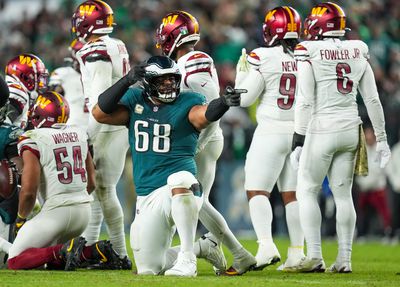
Photo by Mitchell Leff/Getty Images
Development Timeline of Starting OTs
This article asks how long it has taken for starting LTs to come up to NFL speed in pass protection. That is very different from asking about the chance that an OT at a certain draft position will make it as a long-term starter. As a result, the data set is highly cherry picked. I started out by looking for OTs selected in the five drafts from 2017 through 2021 who earned second contracts as starters, or are still starting in their fourth seasons. A larger number of OTs who only started for a season or two before transitioning to other positions, backup roles, or out of the league were not included. Consequently, the numbers can be used as guidance regarding how long would be reasonable to give Coleman to establish whether he is starting LT material. But they don’t tell us much about the chance that he won’t make it.
I also looked at timelines for RTs in pass protection. The results were similar, so I pared it down to LTs for simplicity and brevity. One player who started out at RT and transitioned to LT was also included.
Players Who Stuck with their Drafting Teams
The following figure shows the development in pass protection of seven LTs drafted between 2017 and 2021 who earned second contracts at LT from the team that drafted them (Mailata, Bolles, Miller, Wirfs, Darrisaw, Thomas, Robinson*) and Rashawn Slater, who appears to be on track to do so. *Cam Robinson is a marginal inclusion in this group, for reasons I’ll discuss below. Two more LTs drafted in this period are discussed in the following section.
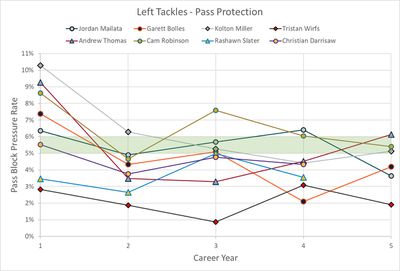
This is a busy graph. Just compare Year 1 and Year 2 of the players’ careers to see the main takeaway.
Out of eight long-term starters (actually 7 plus Rashawn Slater), five started out with Pressure Rates above the crucial 5-6% range (shaded green) in their rookie seasons. As of Sunday’s upset of the Eagles, Brandon Coleman was tracking at 6.12% for his rookie campaign, placing him just ahead of Jordan Mailata’s first season performance.
Tristan Wirfs, Rashawn Slater and Christian Darrisaw performed as mid-range to elite starters in pass protection from their rookie seasons. All three of these players were first round draft picks, with Wirfs and Slater both picked 13th overall.
By the end of their second seasons in the league, every LT who earned a second contract from the drafting team had got their Pressure Rate below 5%, with one exception: the Raider’s Kolton Miller. Miller had the worst rookie season in pass protection, and took four seasons to get below 5%. A few of the LTs regressed a bit in their second or third seasons, but most stayed below 6% Pressure Rate for much of their rookie contracts and beyond. As mentioned above, Cam Robinson is the outlier of the group, since he seldom got below 5%.
It is worth having a look in a little more detail at each of the eight LTs in this group:
Garett Bolles – Denver Broncos, 2017 draft, 1st round, 20th overall
6’5” | 297 lbs | 34.0” arms | RAS 9.46 |College: Utah
Bolles was a Day 1 starter at LT for the Broncos, where he has remained for 8 seasons. Following his rookie contract, he was extended for four years at $17 million APY, and earned a second extension in 2024 (4 years, $20 million APY).
Cam Robinson – Jacksonville Jaguars, 2017 draft, 2nd round, 34th overall
6’6” | 322 lbs |35.5” arms | RAS 7.89 | College: Alabama
Robinson started at LT from Day 1 as a rookie, and held the starting position for the Jaguars for the next 7 seasons. He was franchise tagged in his fifth season (2022). He was tagged and extended in 2022 (3 yrs, $17.6 APY) and then traded to the Vikings this year, along with a conditional 7th round pick, in exchange for a conditional 5th round pick. Robinson just met criterion for inclusion in the long term starters group, by virtue of the contract extension in 2022. However, like most OTs who don’t stay below 5% pressure rate consistently, the team that drafted him eventually moved on.
Kolton Miller – Oakland Raiders, 2018 draft, 1st round, 15th overall
6’9” | 309 lbs | 34 1/8” arms | RAS 9.99 | College: UCLA
Kolton profiled as an exceptionally tall and athletic OT prospect with technique issues to clean up to excel at the next level. He was a Day 1 starter at LT for the Raiders, where he has played ever since. He was extended in 2021 on a 3-year, $18.5 million APY contract.
Jordan Mailata – Philadelphia Eagles, 2018 draft, 7th round, 233rd overall
6’8” | 346 lbs | RAS 8.61 | Condell Park High School, Sydney
Hailing from the Bankstown suburb of Sydney, NSW, Australia, Mailata’s path to NFL success was completely different from the other LTs profiled in this article. The child of Samoan immigrants, Mailata came up through the development ranks of the Canterbury-Bankstown Bulldogs professional rugby team in the Australian National Rugby League. His juniors career was interrupted by a heart condition, requiring surgery. After recovering from surgery, we was offered a contract (1 year, $5,000 AUD) to play for the North Sydney Bears, the reserve team for the legendary South Sydney Rabbitohs. In 2017, Mailata was recruited to the NFL’s International Player Pathway program, and trained in American football at the IMG academy in Florida. He was drafted as a developmental project by the Eagles in 2018. He took his first snap on offense two seasons later in 2020, starting 9 games at LT, and one at RT. The following season, he started 13 games at LT and 2 at RT. From 2022 onward, he has been a full-time starter at LT.
In 2021, Mailata was extended for 4 years at $16 million APY. At today’s exchange rate, the average annual salary of his first extension was around 18 times higher than that of the highest paid player in the Australian Rugby League in 2024. He signed a second extension in 2024 for 3 years at $22 million APY.
Andrew Thomas – New York Giants, 2020 draft, 1st round, 4th overall
6’5” | 315 lbs | 36 1/8” arms | RAS 8.09 | College: Georgia
Thomas has emerged as one of the best LTs in pass protection over the past three seasons, but he didn’t start out that way. He struggled in several games during his rookie campaign, ending the season with a 9.3% Pressure Rate. Over the next three seasons, he emerged as a plus starting LT. He struggled with injury in 2023, and went on season ending IR with a Lisfranc injury in October 2024. The reduced sample size could make his 2024 blocking stats unreliable. Thomas signed a 5-year, $23.5 million APY extension to start the 2024 season.
Tristan Wirfs – Tampa Bay Buccaneers, 2020 draft, 1st round, 13th overall
6’5” | 320 lbs | 34.0” arms | RAS 9.74 | College: Iowa
Wirfs profiled as an immediate starter at right tackle coming out of Iowa and didn’t disappoint. He not only started at RT from Day 1, he was one of the rare OTs who entered the league as an elite player in pass protection. In 2023 he switched to LT and signed a five year extension at $28 million APY.
Rashawn Slater – LA Chargers, 2021 draft, 1st round, 13th overall
6’4” | 304 lbs | 33.0” arms | RAS 9.72 | College: Northwestern
Slater drew questions about lack of length in the draft process, but his combination of strength, athleticism and footwork, as well as the fact that he was the only left tackle to handle top prospect Chase Young, must have convinced the Chargers to try him at left tackle. Slater drew Pro Bowl and second team All-Pro nominations as a rookie and finished 4th in voting for AP Offensive Rookie of the Year. He is one of two LTs in this five year sample to enter the NFL as an elite pass protector. Slater missed most of his sophomore season, but has been a quality starting LT for the Chargers ever since. He must have been good enough at LT to keep rookie phenom Joe Alt on the right side. The Chargers have exercised the fifth-year option to keep Slater in 2025, but have yet to negotiate an extension. It would be a shock if they let him go.
Christian Darrisaw – Minnesota Vikings, 2021 draft, 23rd overall
6’5” | 322 lbs | 34 1/4” arms | College: Virginia Tech
Commanders fans will always remember Darrisaw as the player Ron Rivera should have picked instead of LB Jamin Davis. Darrisaw profiled as an early starter at left tackle. As expected, he earned the starting job by Week 6 of his rookie season and has been a quality starter for Vikings ever since. He signed a 4-year, $26 million APY extension this season, with non-guaranteed years to allow the Vikings to lock him up until 2030. Jamin Davis joined Darrisaw as a teammate in Week 13 on a 1-year $1 million contract, and has played 21 defensive snaps as a Viking.
OTs Heading the Wrong Direction
Two of the players who started at LT throughout their rookie contracts seemed to head in the wrong direction in pass protection. One was traded and is now on his third team. The other’s future is in doubt at the end of his rookie contract.
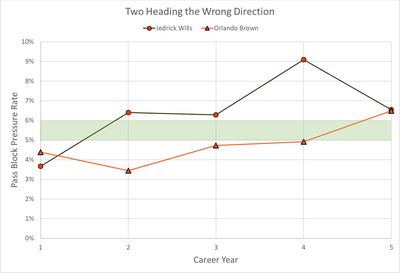
Orlando Brown Jr. – Baltimore Ravens, 2018 draft, 3rd round, 83rd overall
6’8” | 345 lbs | 35” arms | RAS 0.70 | College: Oklahoma
Brown is a massive OT who profiled as a prospect who wins with size and attitude, despite poor athleticism and technique coming out of college. That RAS score is not a typo – Brown scored in the Very Poor range in Agility (5.38 sec shuttle), Explosion (19.5” vertical, 6’10” broad jump), and Speed (5.85 sec 40, 2.0 sec 10 yd split).
Brown was drafted by the Ravens, and became the full-time starter at RT in Week 7 of his rookie season. Brown was nominated to the Pro Bowl in his sophomore season, and remained a starter for Baltimore through the next season, when he moved to LT, and collected a second Pro Bowl nod.
Brown was traded to the Chiefs ahead of the 2021 draft, in exchange for a first round pick (31st overall), a third rounder (No. 94) and a fourth rounder (No. 136), plus a 2022 fifth round pick. He started for two more seasons at LT in Kansas City, earning Pro Bowl nominations in both seasons and blocking for Patrick Mahomes in a Conference Championship loss in 2021 and a Super Bowl Championship in 2022.
Following the 2022 Super Bowl win, the Chiefs allowed Brown to leave in free agency. The Cincinnati Bengals snapped up the four-time Pro Bowl LT, signing him to a four-year, $16 million APY deal.
It is extremely rare for NFL teams to let go of quality starting OTs in their prime. Yet, despite four consecutive Pro Bowl nominations and a Super Bowl ring, Brown is on his third NFL team in seven NFL seasons.
Why would two of the best managed NFL teams part ways with such a Pro Bowl LT? The answer might be that, after a promising start in Baltimore, Brown went backward in pass protection. The Ravens shipped him to the Chiefs for a massive haul of draft picks when he was still allowing lower than 5% Pressure Rates. In his second season with the Chiefs, he broke the 6% barrier and was allowed to walk. In 2023, with the Bengals, he allowed pressure on 8.3% of dropbacks. This season, he seems to have turned the skid around, dropping back down to 4.0%. Perhaps the Bengals found a steal after a rocky first year.
Jedrick Wills Jr. – Cleveland Browns, 2020 draft, 1st round, 10th overall
6’4” | 312 lbs | 34 1/4” arms | RAS 8.43 | College: Alabama
Wills was a top 10 pick in the deep 2020 OT draft class. I have to confess, he is a former MiBV Little Board player. While there was little doubt about who Ron Rivera would pick in the first round that season, Wills was a player I would have liked to see the Commanders find a way to add to the roster.
Wills looked the part of a starting LT in his rookie season with the Browns, earning the start in camp and holding it for five seasons. Despite injury struggles in 2023, the Browns exercised his fifth-year option in 2024. However, after a stellar rookie campaign, Wills has regressed in pass protection, even when healthy. The Browns drafted Dawand Jones to play RT in 2023. In Week 8 this season, Wills was benched to allow Jones to move to LT. After being placed on season ending injured reserve, doubts are being raised about Wills ever returning to Cleveland.
Wills’ name has come up in HH comment threads as a player the Commanders might look to add to shore up the OT position this offseason. Much like many names that were floated last offseason, doing so would seem to be a step in the wrong direction. I doubt he is on Adam Peters’ radar.
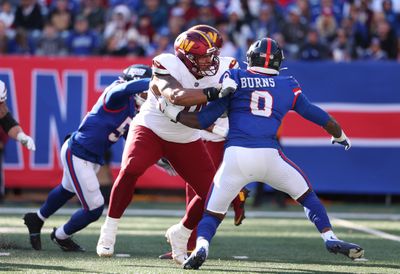
Photo by Al Bello/Getty Images
What it Means for the Commanders
As we have seen, offensive tackles picked outside the top 15 usually take some seasoning to adjust to NFL pass rushers. Some picked in the top 10 (e.g. Andrew Thomas) do as well. The key findings of this analysis are:
- Out of 8 teams that found long-term starting LTs in the five drafts from 2017 through 2021, five of the draftees (63%) allowed more pressures than the average NFL starter in their first seasons. Four (50%) of the eventual long-term starters allowed greater than 7% pressure rates, well outside the acceptable range for veteran NFL starters.
- In all but one case, the critical step up to plus starter level in pass protection occurred in the players’ second seasons at OT. The lone exception, Kolton Miller, made the step up to long-term starter level between his third and fourth seasons.
- Only two of the 8 (25%) quality long-term starting LTs were picked outside of the first round. Both took a full NFL season to demonstrate their starting chops. One of those (Cam Robinson) was eventually traded by his drafting team.
- Offensive tackles with Pressure Rates consistently below 5% tend to get locked up long-term by the teams that drafted them. Those that don’t might still find work as starters, but their futures with the drafting teams are less secure.
To this point in his rookie season, Brandon Coleman has allowed a Pressure Rate of 6.12% in pass protection. That figure positions his rookie season as the fourth-best among the long-term starters profiled in this article.
However, nothing is guaranteed. Two of the ten LTs examined in this article (Orlando Brown), performed much better in pass protection than Coleman as rookies, but then regressed over time.
Bottom Line: If the 10 OTs profiled in this article are any guide, the Commanders should know by the end of next season whether Brandon Coleman is the long-term solution at LT. His performance to date has been promising, as we will see in the second article, coming to a football blog near you, next week.
